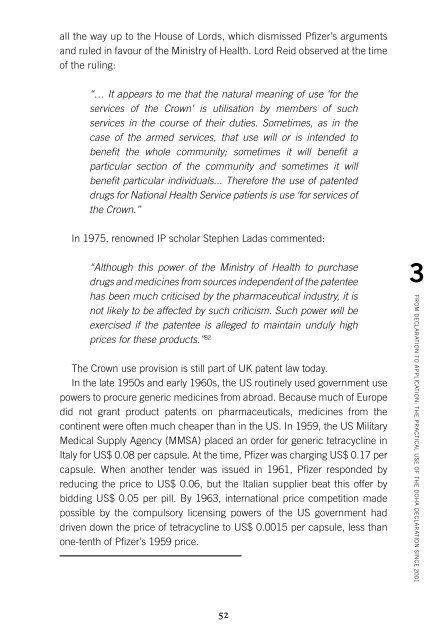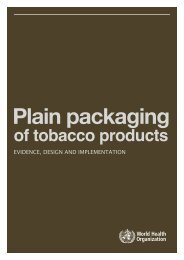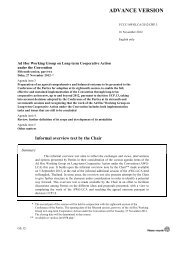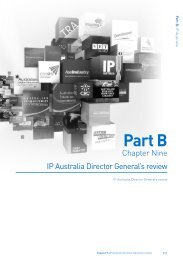PRIVATE PATENTS AND PUBLIC HEALTH
private-patents-and-public-health
private-patents-and-public-health
Create successful ePaper yourself
Turn your PDF publications into a flip-book with our unique Google optimized e-Paper software.
all the way up to the House of Lords, which dismissed Pfizer’s arguments<br />
and ruled in favour of the Ministry of Health. Lord Reid observed at the time<br />
of the ruling:<br />
“… It appears to me that the natural meaning of use ‘for the<br />
services of the Crown’ is utilisation by members of such<br />
services in the course of their duties. Sometimes, as in the<br />
case of the armed services, that use will or is intended to<br />
benefit the whole community; sometimes it will benefit a<br />
particular section of the community and sometimes it will<br />
benefit particular individuals... Therefore the use of patented<br />
drugs for National Health Service patients is use ‘for services of<br />
the Crown.”<br />
In 1975, renowned IP scholar Stephen Ladas commented:<br />
“Although this power of the Ministry of Health to purchase<br />
drugs and medicines from sources independent of the patentee<br />
has been much criticised by the pharmaceutical industry, it is<br />
not likely to be affected by such criticism. Such power will be<br />
exercised if the patentee is alleged to maintain unduly high<br />
prices for these products.” 82<br />
The Crown use provision is still part of UK patent law today.<br />
In the late 1950s and early 1960s, the US routinely used government use<br />
powers to procure generic medicines from abroad. Because much of Europe<br />
did not grant product patents on pharmaceuticals, medicines from the<br />
continent were often much cheaper than in the US. In 1959, the US Military<br />
Medical Supply Agency (MMSA) placed an order for generic tetracycline in<br />
Italy for US$ 0.08 per capsule. At the time, Pfizer was charging US$ 0.17 per<br />
capsule. When another tender was issued in 1961, Pfizer responded by<br />
reducing the price to US$ 0.06, but the Italian supplier beat this offer by<br />
bidding US$ 0.05 per pill. By 1963, international price competition made<br />
possible by the compulsory licensing powers of the US government had<br />
driven down the price of tetracycline to US$ 0.0015 per capsule, less than<br />
one-tenth of Pfizer’s 1959 price.<br />
3<br />
FROM DECLARATION TO APPLICATION: THE PRACTICAL USE OF THE DOHA DECLARATION SINCE 2001<br />
52






